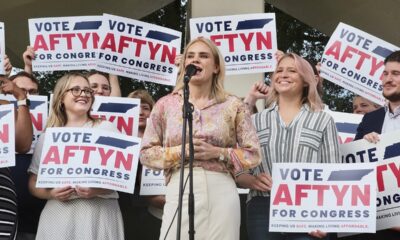Colorado
Colorado House passes bill banning so-called assault weapons

DENVER — Democrats in the Colorado House of Representatives passed a bill on Sunday that would ban so-called assault weapons.
House Bill 1292 passed largely along party lines on a 35-27 vote. It now heads to the state Senate.
HB24-1292, which is sponsored by State Reps. Elisabeth Epps and Tim Hernandez, would define “assault weapon” and ban the manufacture, import, sale, or purchase of such weapons in Colorado.
The bill would also ban the possession of rapid-fire trigger activators, which are devices that can be attached to a gun to increase the speed at which it fires.
Hernandez said Friday his background as a teacher and as the first Colorado state lawmaker from Gen Z (the generation born between 1997 and 2012) provides him with a perspective on guns that differs from most of his colleagues.
“We have been living with mass shootings for my entire life. We have been doing active shooter drills for my entire life. We have been waiting to die in schools because adults would not be bold enough on guns,” said Hernandez. “Then I finally became a teacher, and I sat with my students who were still afraid to die in schools because adults would still not be bold enough on guns.”
Republican lawmakers like State Rep. Matt Soper told Denver7 on Friday the bill violates the Second Amendment rights of Coloradans.
“I can tell you from rural Colorado, the one thing that people hold most dear would be their property and firearms are right there with it,” Soper said. “Firearms are very symbolic of our way of life, of who we are.”
State Rep. Richard Holtorf, a Republican who’s also running for Congress in the Fourth Congressional District, said he doesn’t believe many sheriffs in Colorado will enforce the legislation, should it become law.
“You need to understand that in the 64 counties, I would opine that about 47 of them will never, ever because of those to the Constitution enforce this statute,” said Holtorf.
The County Sheriffs of Colorado opposes the bill.
Its future in the Senate, where more moderate Democrats serve, is unclear.
The Follow Up
What do you want Denver7 to follow up on? Is there a story, topic or issue you want us to revisit? Let us know with the contact form below.

Colorado
Toyota Game Recap: 12/11/2025 | Colorado Avalanche

ColoradoAvalanche.com is the official Web site of the Colorado Avalanche. Colorado Avalanche and ColoradoAvalanche.com are trademarks of Colorado Avalanche, LLC. NHL, the NHL Shield, the word mark and image of the Stanley Cup and NHL Conference logos are registered trademarks of the National Hockey League. All NHL logos and marks and NHL team logos and marks as well as all other proprietary materials depicted herein are the property of the NHL and the respective NHL teams and may not be reproduced without the prior written consent of NHL Enterprises, L.P. Copyright © 1999-2025 Colorado Avalanche Hockey Team, Inc. and the National Hockey League. All Rights Reserved. NHL Stadium Series name and logo are trademarks of the National Hockey League.
Colorado
The Top 50 Bars in Denver Right Now

Valeria Moonch Photography
From dives, cocktail havens and breweries to new watering holes and old classics that stand the test of time, there’s no shortage of places to catch a buzz in the metro area. But which are the best bars of the bunch — the spots are at the top of their game?
For years, we’ve served up an annual list of the city’s Top 100 Bars. But now, we’ve improved our own game, cutting that number in half in order to highlight only the best of the best, and then updating the list next spring, to make sure all our choices are still winners. One thing hasn’t changed, though: The lineup still offers a wide variety of places to imbibe, whether you prefer a low-key neighborhood hang or want to impress a date with an upscale escape.
And there are impressive options. This edition of the list includes eight recent additions to the bar scene, three of which could just as easily be considered restaurants: Rougarou, Malinche Audio Bar and the Michelin-starred Mezcaleria Alma.
Great bars with great food are not a new trend — the list also includes older spots like Pony Up, where French dips star, and My Brother’s Bar, which is known as much for its burgers as its booze. But this trio blurs the line even further, with creative fare that’s as much of a draw as the cocktails, while still being the kind of place where you can belly up and have a good time whether you’re dining in or not (though let’s be real, you’re gonna want to show up thirsty and hungry).
But we’re also pouring out some old favorites, too, which serve up a strong sense of this town as well as strong drinks.
Jump to:
Keep reading for the Top 50 Bars in metro Denver right now.

New and Noteworthy Denver Bars
The top bars that opened between Labor Day 2024 and November 2025.
The Devil’s Drink
Highland
1553 Platte Street
Andrew Harris went from food-truck operator to bar owner when he debuted the first iteration of the Devil’s Drink, his “underworld speakeasy,” in 2023. In September, the bar moved into its new home, a subterranean space that’s a much better fit — and much larger than its former digs. Now, patrons descend a set of stairs to reach the red-hued watering hole with a menu that includes over a dozen versions of the popular drink of the moment: the espresso martini. The Devil’s Drink 2.0 also includes a room with pool tables for your playing pleasure, and don’t miss the coffin photo opp outside of the restrooms.
Latchkey
City Park
1308 East 17th Avenue
In January 2025, Cade Cauley, founder of Austin’s Latchkey, brought a second location of his bar to the former Alpine Dog Brewing space, and it has quickly become a neighborhood favorite. The cute Canman logo beckons guests into this welcoming, cozy spot that doesn’t take itself too seriously. Its patio is dog-friendly, and it has a solid selection of beer and cocktails. The only grub available in-house is frozen pizza, but there’s usually a food truck out front for hungry patrons. The bar has a lovely staff, is LGBTQ+ friendly, hosts Thursday night music bingo and has a pool table and plenty of TVs, making it great for watching the Broncos as they (hopefully) continue their winning streak this season.
The Lowbeam
City Park
3401 East Colfax Avenue
For seven years, Middleman was a Colfax fixture near the Bluebird, so when it closed in the summer of 2025, it left a cocktail-shaped hole in the hearts of many in the neighborhood. But not for long. Enter the female-owned Make Regulars group, which is behind many of our favorite local watering holes, including its newest, the Lowbeam, which started shining in October. It’s kept much of what we loved about Middleman alive (affordable drinks, friendly staff, low-key vibes) in a refreshed space that’s already a regular stop for pre- and post-show shenanigans.
Malinche Audio Bar
Highland
1541 Platte Street
Jose Avila’s La Diabla in the Ballpark neighborhood is a favorite for tacos, pozole and mezcal, so when he added an actual mezcal bar to his growing roster of spots, we had high expectations. Malinche delivers, with a custom sound system that plays tunes from Avila’s personal collection of vintage Mexican records, creating a party-like atmosphere in this intimate space where you can sip flights of agave spirits, indulge in thoughtful cocktails and experience what Avila dubs “Nikkei-Mexa,” dishes that combine traditional Mexican ingredients with Japanese-inspired touches.
Mezcaleria Alma
Highland
2550 15th Street
Johnny and Kasie Curiel seem to be unstoppable, with a growing restaurant group that currently includes four metro spots. But if we’re picking favorites, it has to be Mezcaleria Alma, the lively next-door neighbor to their first eatery, Alma Fonda Fina. It not only scored a Michelin star just months after its debut, it also landed on Punch‘s 2025 list of the Best New Cocktail Bars in the Country. Here, boldly flavored dishes inspired by Mexico City pair with an agave spirits-centric beverage program that’s just as impressive as the team’s culinary chops.
The Pearl
Five Points
2195 California Street
In April 2025, The Pearl moved into the former Mercury Cafe, a legendary establishment that first opened in 1975 and moved into this building in 1990. As a sapphic reinvention, the bar and café maintain the heart and soul of the Merc, with its bohemian décor and eclectic vibe, while bringing a new LGBTQIA+ focus to the beloved establishment. In addition to cocktails, beer, wine, coffee, tea and light bites, there’s a calendar of events ranging from poetry open mics to jazz jams, dance lessons, game nights, karaoke, lectures, tarot readings, trivia, concerts and more. In short, the Pearl has managed to give fresh life to the space while keeping the Merc’s legacy alive.
Rougarou
Five Points
2844 Welton Street
Husband-and-wife duo McLain Hedges and Mary Allison Wright are the coolest of the local bar scene’s cool kids, as evidenced when their first standalone spot, Yacht Club, was named the Best U.S. Cocktail Bar at the 2024 Spirited Awards. On the heels of that accomplishment, the two opened a second bar in April 2025. Named for a mythical swamp creature, Rougarou embraces the spirit of the couple’s Southern roots in a way that’s a little bit fancy, a little bit funky and a whole lot of fun. Belly up for a muffalata martini or a bananas foster julep, which simply must be paired with bites created by Wright’s brother, John David, including the green-tomato-spiked blue cheese tart, which has become a fast fan favorite.
Semiprecious
Sunnyside
2839 West 44th Avenue
As the owner of two L.A. hot spots (Thunderbird and Night on Earth), Mike Capoferri knows a hell of a lot about bars. In May 2025, he brought that knowledge to the Mile High with the debut of Semiprecious, which has the relaxed feel of a dive bar combined with the thoughtful design of a welcoming neighborhood spot and a cocktail list that goes well beyond the basics. This spot uses a high-tech approach, but most of the magic happens behind the scenes, so all you know is that your bubbly tomato highball arrives in seconds and that sour cream and onion martini is icy cold perfection. While the drinks come out quickly, this is the kind of place where you’ll want to linger for as long as possible.

The Best Classic Denver Bars
Watering holes that have stood the test of time.
Candlelight Tavern
Washington Park West
383 South Pearl Street
This friendly neighborhood bar is beloved by residents of all stripes in the Wash Park area. Once a seedy, smoky dive, it’s been spruced up over the years – but consistency and simplicity are key. You can count on no-frills, tasty pub grub, including a great basic bar burger. The warm glow of the Candlelight’s vintage sign still illuminates the way to one of Denver’s oldest and best bars.
The Castle
Littleton
6657 South Broadway
The Castle rules in the south suburbs. Yes, the building even looks like a castle, and the sunken bar is sided by comfy chairs that make for a royally fun day or night of imbibing. The vibe is relaxing and unpretentious, as are the patrons. Snag a twenty-ounce personalized mug for $20, good for a lifetime of 20-ounce pours for 16-ounce prices. The fare is simple but tasty, with budget specials such as ten wings for $10 every Thursday and buy-one-get-one-half-off burgers (among the best in town) on Tuesdays. With karaoke, bingo, trivia and chatty regulars of all stripes, you’ll never be bored when you storm the Castle.
Charlie Brown’s Piano Bar & Grill
Capitol Hill
980 Grant Street
Colorful characters from Denver’s past are rumored to have bellied up to the bar at Charlie Brown’s, which has been open since Prohibition ended. A sprawling spot with nightly piano sing-alongs, it lives up to its slogan: “Something for everyone.” Couples, friends, tourists, young professionals, senior citizens, college kids and even celebrities enjoy the stiff drinks, huge food menu, enclosed patio and free drinks for revelers celebrating their birthdays.
Cruise Room
Union Station
1600 17th Street
As Prohibition ended, this bar inside the Oxford Hotel was designed to look like the lounge on the Queen Mary (hence the name), then got a quick remodel a decade later when the frieze with Hitler’s face — one of a dozen international toasts circling the walls — was deemed politically incorrect. In the 1960s, it was the headquarters for a group of carousers known as the Evil Companions; in the ’90s, it was discovered by hipsters. Today, you’ll find all kinds of passengers hopping aboard barstools to bask in the red light and down classic cocktails like martinis and Manhattans.
Don’s Club Tavern
Speer
723 East Sixth Avenue
Also known as Don’s Mixed Drinks (because of the wording on the old-school neon sign outside), this dive that’s nearing eighty years old has some serious staying power. Purchased by local bar conglomerate Little Pub Company in 2006, Don’s has retained a welcoming “old man’s basement” atmosphere. The secluded smoking patio and Skee-Ball machine are highlights, as is the vending machine dispensing fun packs of goodies such as condoms, burritos, cigarettes and candy. The bar caters to old-timers during the day and is a packed hangout for the younger set at night.
Lakeview Lounge
Edgewater
2375 Sheridan Boulevard
While the patio outside the Lakeview Lounge has a prime view of Sloan’s Lake, Sheridan Boulevard and the Denver skyline, those who love authentic dives will be more captivated by the view inside. The Lakeview is a weathered, classic saloon that time forgot. Clearly a drinker’s haven in an increasingly upscale area, the dimly lit lounge serves mystery shots in brown paper bags and very stiff, cheap drinks. Regulars throw quips, dice and dollar bills at each other, taking a break to plug the excellent jukebox. For those wanting booze for breakfast, the bar opens at 7 a.m.
Lions Lair Lounge
Capitol Hill
2022 East Colfax Avenue
This address has long housed an independent venue — the Aladdin Tavern in the ’30s, then the Playboy Lounge until Hugh Hefner paid its then-owner $5,000 to change the name. In 1967, the club was purchased by John Lyons, who transformed it into the Lion’s Lair, and its current owners are keeping the bar’s legacy alive. Despite struggles during the BRT construction project, the Lair is still one of the best places in town to sip cheap drinks and see live music. This is a living piece of Colfax history that we hope never changes.
My Brother’s Bar
Highland
2376 15th Street
Yes, My Brother’s Bar has a fascinating history: The building has housed a bar since the 1870s; Beat inspiration Neal Cassady hung out here when it was Paul’s Place; and as My Brother’s Bar, it’s survived with no TVs while playing classical music and serving as a neighborhood joint for the whole city. But the most interesting chapter is the current one: After four decades, a longtime employee and her family bought the place from owner Jim Karagas in 2017, vowing to keep My Brother’s Bar going. And the Newmans have, without sacrificing any of that historic charm — or changing the condiment caddies that accompany the beloved parchment-wrapped burgers.
Pete’s Satire Lounge
Capitol Hill
1920 East Colfax Avenue
Pete Contos, the late Greek restaurant magnate, purchased the Satire over sixty years ago. From its classic neon sign to its legendary history (Bob Dylan and the Smothers Brothers both performed here), this spot is old Denver through and through, even following a recent update and remodel headed up by Contos’s grandson Alex Barakos that includes a game room and revamped patio, from which you can watch the action on Colfax. The Satire is a straight-ahead saloon that doesn’t put on airs or follow trends, and the off-kilter assortment of characters who work and drink here wouldn’t have it any other way.
PS Lounge
Congress Park
3416 East Colfax Avenue
The PS Lounge is a throwback like no other. The cash-only bar still looks and feels straight out of the ’80s, which is when it opened. Owner Pete Siahamis calls it a “girls’ bar” and makes sure every woman who crosses the threshold gets a single rose and a syrupy-sweet Alabama Slammer shot. Stop in to pre-game before a show at the Bluebird, or to shoot a game of pool, or to play all your favorites from the old-school jukebox, and if you have one too many shots, you can even things out with a pie from Enzo’s on Colfax, which replaced the former long-running Enzo’s in the connected space next door in March 2025.
The Thin Man
City Park
2015 East 17th Avenue
The Thin Man emanates a strong gravitational pull from its location on a darkened string of blocks between Colfax, Uptown and City Park, drawing in drinkers from near and far. Owner Eric Alstad, who is Greek Orthodox, got his priest’s blessing before opening the joint in 2001, covering the walls of the narrow space with Christian icons. These days, the patrons are as eclectic as the decor — and just as entertaining. Praise Jesus!

Denver Cocktail Bar Hot Spots
The bars that are mixing up the best boozy concoctions.
The Block Distilling Co.
RiNo
2990 Larimer Street
It shouldn’t be a surprise that some of the best places to get a high-quality cocktail are distilleries. Spots like the Block know their spirits inside and out, after all, but this one truly steps things up by consistently serving some of the most creative libations in the city, often made with unexpected ingredients and special touches, like its current seasonal spin on a Greyhound made with Hatch green chile and smoked cactus-infused vodka.
The Electric Cure
Edgewater
5350 West 25th Avenue
Lexi Healy and Veronica Ramos know how to create a memorable tiki bar experience, from the horror theme of Honor Farm to the gay pirate ship theme of their upstairs hideaway Hell or High Water. But it’s their original spot that’s kept us coming back most frequently. Over four years, the Electric Cure has become dependable for being completely surprising. You never quite know what you’re going to find going on in this funky bar that’s not afraid to embrace being all-out weird — although at least one flaming cocktail is typically a solid bet.
The Family Jones Spirit House
Highland
3245 Osage Street
With luxurious blue velvet seating and a shiny copper still overhead, this is the most stylish distillery tasting room around, especially after a recent refresh of the space and the cocktail menu. The finely crafted bottled spirits from the Family Jones are a treat on their own, but they truly shine when you’re sipping them in concoctions created by the mad geniuses behind the bar.
Pretty Neat
Baker
114 South Broadway
Xanthus Be Dell and his wife, Cristy, moved to Denver in May 2021 after years of running large-scale beverage programs for music festivals and other events while based in Los Angeles. With Pretty Neat, which debuted in November 2023, the goal was to offer well-made, classic cocktails for a reasonable price (most these days are around $13). The formula has been a hit on South Broadway, where the place has become a staple for regulars who just want to enjoy a good drink for a good price — and that’s pretty neat.
Run for the Roses
Union Station
1801 Blake Street
This subterranean, gambling-themed Dairy Block cocktail lounge has become a destination for drink aficionados. Comb through the clever deck-of-cards menu and you’ll find special reserve cocktails made with vintage liqueurs and spirits — a passion of owner Steven Waters. He often imports these hard-to-find bottles, having first verified their authenticity from halfway around the globe. The result is an impressive collection that makes it well worth finding your way inside (the bar’s not a speakeasy, it’s just hard to locate) using the elevator inside Free Market.
The Stockroom
Arvada
5713 Olde Wadsworth Boulevard
In the back of Spirits Wine Provisions is a door to an old stockroom. While the sign may say it’s for staff only, those who enter will be rewarded not with a job, but with access to a ritzy speakeasy with a list of classic cocktails as well as twists on the standards. Not sure what you’d like? Chat up the bartender and get a personalized recommendation.
Traveling Mercies
Aurora
2501 Dallas Street
Chef and restaurant owner Caroline Glover opened her second concept in December 2023, just steps from her first restaurant, Annette. This cozy upstairs lounge that’s hidden from the crowds at Stanley Marketplace is one of the best places to catch a sunset. The menu is concise — just a handful of thoughtful items with a special focus on creative rum-based libations, carefully curated wines and coastal bites like shrimp cocktail, anchovies and East Coast oysters.
Union Lodge No. 1
Central Business District
1543 Champa Street
Located just off 16th Street in the heart of downtown, walking into Union Lodge No. 1 is like entering another era, where finely crafted cocktails star amid the classy digs with a rustic, old-school Americana edge. Owners Lenka Juchelkova and her husband, Mike Huggins, also brought the city Arvada Tavern and the Tatarian, both of which are worth a visit, too. But in a complicated world, we’re loving the throwback simplicity of Union Lodge’s hospitality and pre-Prohibition era libations.
Williams & Graham
Highland
3160 Tejon Street
Sean Kenyon’s LoHi speakeasy, which opened in 2011, is the OG of Denver’s cocktail scene and remains at the top of the game today. To enter the bar, you go through a bookcase, which you can only access when there’s a seat for you and your party inside; that means no crowding or people trying to encroach on your space or table. And you’ll want room to enjoy your cocktails, expertly made to your taste from the large menu — or you can ask the bartender to make a custom drink. Then pair it with bites like one of the best burgers around, deviled eggs and raw oysters.
Yacht Club
Cole
3701 Williams Street
While Rougarou is their latest hit, Mary Allison Wright and McLain Hedges aren’t slacking at their OG Denver spot, which was located inside the Source before moving next door to Brasserie Brixton in late 2021. Yacht Club effortlessly mixes high and low with a killer natural wine list and cocktails alongside a menu of hot dogs, all paired with a vibe that’s still cool enough for a first date. In 2024, their efforts were rewarded when Yacht Club was named the Best U.S. Cocktail Bar at the Spirited Awards during Tales of the Cocktail — news that came as no surprise to anyone who has stepped inside.

Neighborhood Bar Favorites in Denver
The comforting go-tos that always deliver a good time.
Aspen Lodge Bar & Grill
Westminster
8125 West 94th Avenue
What do lava lamps, Christmas trees and Iron Maiden have in common? Mesut Cetin, the amiable owner and chef of Aspen Lodge, loves them all, which is why his Westminster joint is packed with an impressive collection of retro lights, year-round holiday decor and odes to metal. His other passion: sharing food from his native Turkey, which he serves alongside typical bar fare and “the best Philly cheesesteak in 666 miles radius,” as the sign out front proclaims.
Bedlam
LoDo
1516 Wazee Street
Longtime industry pro Jacob Berndt debuted his first solo venture in May 2024 inside the long, narrow downtown space that was home to Deep Roots Winery & Bistro before sitting empty for four years. With the help of his siblings, Berndt transformed the space with art and knick-knacks that give it the vibe of a well-worn neighborhood watering hole. A small food menu of upscale bar bites pairs perfectly with Bedlam’s decidedly not-crazy mix of high-end spirits, simple yet satisfying cocktails and low-bar, budget-friendly options.
The Crypt
City Park
1618 East 17th Avenue
Metal, mostly meat-free food (along with a damn good meaty burger) and a reverence for death are all on full display at this spot founded by longtime Tooey’s employee Priscilla Jerez and business partners Chris Maynard and Dale Canino in 2022. A destination for live music and late-night revelry, it has a smoking patio out front that’s often filled with people trading stories (and lighters) under the moonlight. Inside, you’re highly likely to run into at least a few old friends while grabbing a cocktail from one of two bars.
Embassy Tavern
RiNo
3463 Larimer Street
This bar on a prime corner spot in RiNo is in a building that started life a century ago as a drugstore, then housed various incarnations before it became Phil’s Place in 2002. In 2018, it was taken over by a group of bar pros who changed the name but kept its spirit intact, offering a low-key respite from the increasingly trendy neighborhood outside, complete with pinball machines, a spacious, smoker-friendly back patio and a giant moose head overseeing the action at the bar.
Fort Greene
Globeville
321 East 45th Avenue
Tucked away in a space that looks totally unassuming from the outside, this bar is a cool and quirky secret escape filled with plants and mismatched furniture. Before Fort Greene debuted in 2015, the address was home to divey favorite Crash 45, and before that the White Owl, and before that the Portulaca Cafe, a Slavic speakeasy. This incarnation has a well-worn charm that’s made it a go-to spot for artists, musicians and other members of Denver’s creative class.
Li’l Devil’s Lounge
Baker
255 South Broadway
For thirteen years, this li’l spot has been a gay-borhood bar with a hidden-in-plain-sight patio oasis on South Broadway. It even has its own parking lot (a rarity in this area), which leads directly into the outdoor party that typically ramps up every evening. From simple mixed drinks to creative cocktails and a damn fine martini, the bartenders here can do it all, and the friendly vibes beckon patrons to stay for just one more round…okay, make it two.
Lincolns
Union Station
1801 Wynkoop Street
You’ll have to work to find the entrance to Lincolns, but that’s half the fun. The space, outfitted with plenty of comfy seating, opened…somewhere inside the Ice House building near Union Station in August 2024. Owner Mark Ohlson was over overpriced cocktails, and set out to create a different kind of bar experience. He debuted the first Lincolns in Portland, Maine, then added a second in Burlington, Vermont, before bringing the concept — a hidden, cash-only bar where all the simple mixed drinks, beer and wine are $5 — to the Mile High, and we’re happy to be privy to the secret.

Lincoln’s Roadhouse
Platt Park
1201 South Pearl Street
Unlike the new, hidden Lincolns, this rowdy bar has been rocking loudly for over a quarter century. It draws crowds on Friday and Saturday nights, when live blues fills the space, but it’s a hit anytime, thanks to its no-frills, all-fun New Orleans-inspired attitude. We love to sip Hurricanes at the bar, and the kitchen is no slacker, either, dishing up some mighty fine Cajun fare, including po’boys, gumbo and crawfish etouffee.
My Boy Tony
Berkeley
4280 Tennyson Street
There have been a lot of changes on Tennyson Street in recent years, including the closure of BookBar after a decade. That’s when Eli Cox, owner of Berkeley Supply, stepped in to make sure the space continued to be a community gathering place. In November 2023, he opened My Boy Tony, a warm, welcoming and beautifully designed bar and patio where friends and neighbors greet each other with smiles over cocktails, mocktails, craft beers and an impressive natural wine list.
Pony Up
LoDo
1808 Blake Street
Pony Up’s incredible staff and surprising cocktails make it well worth a trip to LoDo. The neon signs, French bulldog art and references to The Outsiders only add to the ambience at this bar, which is particularly popular with those in the hospitality industry, thanks to a late-night food menu that includes stellar French dips. The Get Crazy & Pony Up shot showcases everything great about this spot, with George Dickel Tennessee Whisky and an au jus chaser that somehow work perfectly together. We’ll never stop saddling up.
RiNo Country Club
RiNo
3763 Wynkoop Street
There are a few reasons that this bar has become one of our favorite spots to pre-game for shows at Mission Ballroom since it opened in 2022. First, it has some solid drink specials, making it way more affordable than ordering booze at the music venue. It’s also home to a nine-hole mini golf course, and lifetime memberships are available for just $10. Plus, you can grub at Dalton’s, the walk-up window that slings one of the best burgers in town, along with Eagles game-day specials during football season that include a cheesesteak, roast pork hoagie with broccoli rabe and crab fries.
River
RiNo
3759 Chestnut Place
This building was once a true dive, the Welcome Inn; River took over in 2021. Four years into its run, River has found its flow as a spot that makes you feel like you’re hanging in the basement of the cool artsy kid from high school, complete with a back “patio” that’s really just a mish-mash of old furniture. Check it out during Power Hour, from 6 to 7 p.m.,when you can score Bud, Bud Light, pickle shots and lemon drops for just a buck each. The bar also regularly hosts events like Tuesday open mic sessions and Dub Wub Saturdays.
The Scapegoat
Sunnyside
3801 Osage Street
A solid neighborhood bar needs a few ingredients to become truly great, though they are hard to pin down. There’s the natural camaraderie that forms between patrons and staff alike, the kind of atmosphere that lends itself to sudden sing-alongs with whatever is playing on the sound system, and hey, a game of Buck Hunter doesn’t hurt, either. The Scapegoat has all that and more, including a collection of eclectic art and taxidermied goats that make it feel like an old favorite despite being just two years old.
TrashHawk Tavern
Overland
1539 South Broadway
There always seems to be something happening at TrashHawk, which is one of the many reasons it’s been on our top bars list since its 2021 debut. Owner Erin Homburger, known to many regulars as “Trash Mom,” has worked hard to create the kind of place in which you can relax, whether you’re taking advantage of the long and generous happy hour, hitting up the rotating food trucks outside, or entering a cribbage tournament. The bathrooms are plastered with old cigarette and booze ads, the walls are lined with nostalgic memorabilia, and the vibes are 100 percent trashy in only the best ways.
This year, make your gift count –
Invest in local news that matters.
Our work is funded by readers like you who make voluntary gifts because they value our work and want to see it continue. Make a contribution today to help us reach our $50,000 goal!

Denver Beer and Wine Destinations
The places to indulge your local craft cravings.
Bierstadt Lagerhaus
RiNo
2875 Blake Street
Ashleigh Carter and Bill Eye opened this brewery in 2016. It specializes in lager beers, including three core brews: its Helles, its Dunkel and its Slow Pour Pils, perhaps the most lauded beer in Colorado. Beyond Bierstadt’s propensity for making some of the best craft beers in the state, it boasts a comfortable, expansive space that regularly hosts large events, pop-ups, games and trivia, while also offering plenty of corners to tuck into for an intimate experience.
Bigsby’s Folly Craft Winery
RiNo
3563 Wazee Street
Bigsby’s Folly aims to bring the soul of wine country to the heart of RiNo. Housed inside a 130-year-old warehouse, the combination bar/tasting room/restaurant/production facility blends industrial grit with refined accents, like soaring 30-foot raftered ceilings and massive glass chandeliers. The space is equally suitable for enjoying a relaxed glass of post-work wine on one of the plush couches, or attending a tasting or blending session at the metal-and-wood tables. The wines are primarily small-batch vintages sourced from grapes across California, Oregon, Washington and even Colorado by winemaker Brian Graham, who studied and apprenticed in Bordeaux, France.
Blanchard Family Wines
LoDo
1855 Blake Street
Tucked into the bustling alleyway of Denver’s Dairy Block behind the Milk Market, the Blanchard Family Wines tasting room is a space both comfortable and luxurious at the same time. The wines featured include not only those made by brothers Mark and James Blanchard—utilizing grapes imported from California and finished in-state — but also from a range of Colorado-based vineyards. Order by the glass or by the bottle, or opt for one of many wine flights. Education is a big focus here, with classes spanning wine pairing, storage and serving, and even choosing the right glass for the right wine.
Bull & Bush Brewery
Glendale
4700 East Cherry Creek South Drive
Step inside this dark, cozy English-style pub and you’ll understand its staying power: It turned 54 in 2025. Now run by second-generation owners, “the pub you’ve been practicing for” (as the motto goes) serves a long menu of England-meets-Colorado comfort food, including French onion soup, bangers and mash, and green chile-smothered mashed potatoes, as well as both innovative and traditional house-brewed beers. There’s also a Scotch list to warm the cockles of your heart.
Cohesion Brewing
Clayton
3851 Steele Street
Since opening in 2021, Cohesion has become one of the top destinations for out-of-towners, local industry workers and beer aficionados drawn by its Czech-style lagers served in a very traditional way: from side-pull Lukr taps, with plenty of creamy foam on top. (The exact amount depends on which style of pour you choose.) The bar itself is striking, with gorgeous tilework serving as a backdrop and a wood-paneled nook reminiscent of old Europe.
ESP HiFi
La Alma/Lincoln Park
1029 Santa Fe Drive
ESP HiFi, at its heart, is a vinyl listening bar first, with plenty of options for libations to go along with your audio intake. Coffee, tea, cocktails and beer are all on the menu. But what stands out is an all-natural wine list designed to match any mood or emotion that patrons bring with them. Designed after the Japanese “kissa” — where the music may be loud, but the mood still soft — ESP also has perhaps the best wine club in town, featuring two bottles of wine and your choice of vinyl record for only $100 a month.
Hogshead Brewing
Sloan Lake
4460 West 29th Avenue
In 2012, Hogshead Brewery transformed a former gas station into an English-style brewery and taproom. Today, it’s one of the last remaining Colorado breweries to serve cask-style beer, and its intimate neighborhood taproom draws drinkers from near and far. The roster has expanded in recent years to include beers outside of the English category, but the changes feel within the umbrella of authenticity.

The Full List, A-Z
Aspen Lodge Bar & Grill, Westminster
Bedlam, LoDo
Bierstadt Lagerhaus, RiNo
Bigsby’s Follies, RiNo
Blanchard Family Wines, LoDo
The Block Distilling Co., RiNo
Bull & Bush, Glendale
Candlelight Tavern, Washington Park West
The Castle, Littleton
Charlie Brown’s Piano Bar & Grill, Capitol Hill
Cohesion Brewing, Clayton
Cruise Room, Union Station
The Crypt, City Park
The Devil’s Drink, Highland
Don’s Club Tavern, Speer
The Electric Cure, Edgewater
Embassy Tavern, RiNo
ESP HiFi, La Alma/Lincoln Park
The Family Jones Spirit House, Highland
Fort Greene, Globeville
Hogshead Brewing, Sloan Lake
Lakeview Lounge, Edgewater
Latchkey, City Park
Lil Devil’s Lounge, Baker
Lincolns, Union Station
Lincoln’s Roadhouse, Platt Park
Lions Lair Lounge, Capitol Hill
The Lowbeam, City Park
Malinche Audio Bar, Highland
Mezcaleria Alma, Highland
My Boy Tony, Berkeley
My Brother’s Bar, Highland
The Pearl, Five Points
Pete’s Satire Lounge, Capitol Hill
Pony Up, LoDo
Pretty Neat, Baker
PS Lounge, Congress Park
RiNo Country Club, RiNo
River, RiNo
Rougarou, Five Points
Run for the Roses, Union Station
The Scapegoat, Sunnyside
Semiprecious, Sunnyside
The Stockroom, Arvada
The Thin Man, City Park
TrashHawk Tavern, Overland
Traveling Mercies, Aurora
Union Lodge No. 1, Central Business District
Williams & Graham, Highland
Yacht Club, Cole
Colorado
Family of Colorado inmate files lawsuit against jail for her death

The family of a former inmate in Colorado is filing a federal wrongful death lawsuit against the Jefferson County Jail.
The lawsuit claims jail staff caused the in-custody death of Ashley Raisbeck in December 2023. It says the jail gave Raisbeck an antibiotic that she was allergic to and then failed to call 911 for an hour after she showed signs of a medical emergency.
Her mother, Jamie Raisbeck, and other family members believe this is a larger issue.
“It’s disgusting, it’s not okay,” Jamie Raisbeck said. “Along the way, I’ve been trying to make as much noise as I can. I want to make a change in the laws on how inmates are being treated with their medical care.”
The lawsuit also claims her death was not properly investigated. A critical incident response team led by the Lakewood Police Department presented evidence in the case to the district attorney’s office in 2024. It found no criminal conduct by law enforcement that caused her death, and the DA did not file criminal charges in the case.
-

 Alaska6 days ago
Alaska6 days agoHowling Mat-Su winds leave thousands without power
-

 Politics1 week ago
Politics1 week agoTrump rips Somali community as federal agents reportedly eye Minnesota enforcement sweep
-
Ohio1 week ago
Who do the Ohio State Buckeyes hire as the next offensive coordinator?
-

 Texas6 days ago
Texas6 days agoTexas Tech football vs BYU live updates, start time, TV channel for Big 12 title
-

 News1 week ago
News1 week agoTrump threatens strikes on any country he claims makes drugs for US
-

 World1 week ago
World1 week agoHonduras election council member accuses colleague of ‘intimidation’
-

 Washington3 days ago
Washington3 days agoLIVE UPDATES: Mudslide, road closures across Western Washington
-

 Iowa5 days ago
Iowa5 days agoMatt Campbell reportedly bringing longtime Iowa State staffer to Penn State as 1st hire


























